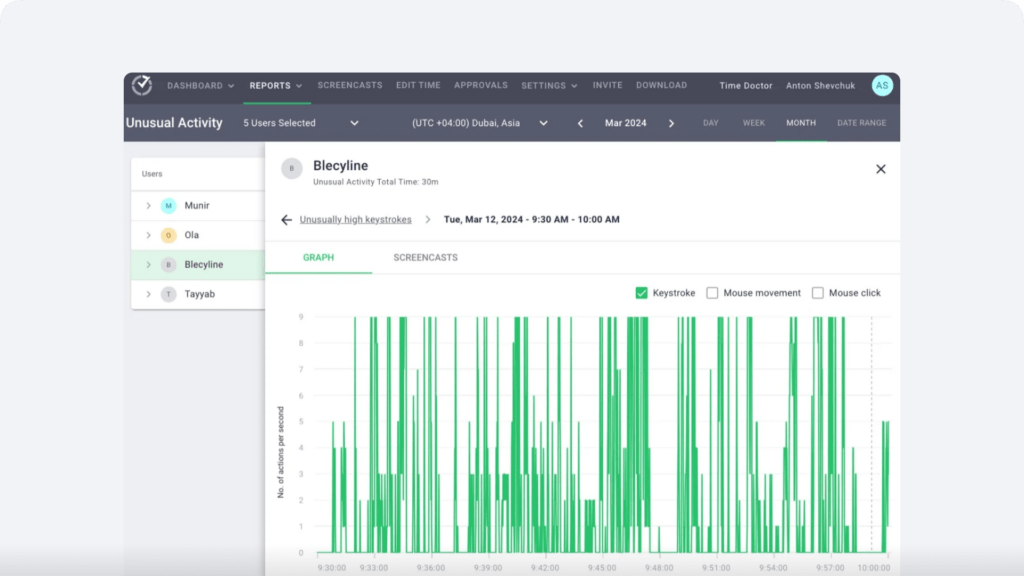Time Doctor is a widely used workforce analytics software, but some employees attempt to cheat the system. This article explores common methods for cheating Time Doctor, the tactics some users employ, and why these methods are not effective in the long run. Understanding these tactics can help businesses identify attempts and ensure accurate time tracking.

How to cheat Time Doctor with mouse jiggler software
One of the most popular methods for cheating Time Doctor is using mouse jiggler software. These tools simulate constant mouse movement to prevent the system from logging idle time. However, while a mouse jiggler may trick Time Doctor’s idle detection, it cannot simulate real productivity. Time Doctor’s screenshot feature, for instance, will show whether or not actual work is being done during this period.
How employees use mouse jigglers to trick Time Doctor idle time tracking
Mouse jiggler tools work by moving the cursor at intervals to create the illusion of activity. Employees use these tools to avoid being marked as idle when they are away from their computers. However, Time Doctor can track not only mouse movement but also keystrokes and application usage, making it difficult to sustain this trick without being caught.
How to cheat Time Doctor with task switching and automation software
Another common method involves using task switching or automation software to trick Time Doctor into logging more time than actually worked. By toggling between tasks or applications, employees try to create the appearance of continuous work. Automation tools can also be used to perform basic tasks while the employee is away from the desk.
Task switching to manipulate Time Doctor’s time tracking
Some employees attempt to manipulate Time Doctor by frequently switching between tasks or applications. For example, they may open multiple windows and switch between them to simulate multitasking. However, Time Doctor’s ability to track specific tasks and categorize them by activity level makes this an unreliable method. Additionally, prolonged inactivity on primary work applications will still trigger idle time alerts.
How to fake Time Doctor screenshots by manipulating remote desktop tools
Some employees use remote desktop tools or screenshot manipulation techniques to falsify screenshots taken by Time Doctor. They may use screenshots from past work sessions or even use a remote connection to control the work environment without being physically present.
How employees use remote desktop tools to bypass Time Doctor’s screenshot monitoring
Remote desktop tools allow employees to control their work environment from a separate device. This trick can potentially fool Time Doctor into thinking they are active at their workstation. However, the software can still detect idle time through lack of keystrokes or mouse movements on the host computer, which often leads to detection.

How to cheat Time Doctor’s mobile app tracking
Time Doctor offers mobile app tracking to ensure employees working remotely or on the go are still productive. Some users try to cheat the system by pausing the mobile app or inputting inaccurate data manually to log work time that wasn’t actually spent on productive tasks.
Exploiting gaps in Time Doctor’s mobile tracking features
Employees sometimes attempt to manipulate Time Doctor’s mobile app by pausing tracking during breaks or falsely logging time after tasks are completed. However, as with the desktop version, Time Doctor tracks real-time activity, and discrepancies between task times and actual work can lead to suspicion.
How Time Doctor’s unusual activity report detects time tracking fraud
Without advanced tools, identifying time tracking fraud can be challenging, requiring manual investigation. Time Doctor’s Unusual Activity Report automates this process using AI and machine learning. It analyzes typical work patterns, detecting anomalies automatically, and flagging suspicious behavior.

How Time Doctor detects unusual activity
Time Doctor’s Unusual Activity Report monitors various signs of potential cheating, including:
- Excessive typing or high keystrokes per second.
- Long periods of mouse movement without clicks.
- Sudden increases in mouse click activity.
- Repeated, consistent patterns of mouse movements or keystrokes.
- Extended periods of keystrokes without any mouse movement.
Time Doctor isn’t a keystroke logger; it tracks the level of keyboard activity without recording specific keys. The Unusual Activity Report provides timestamps of unusual behavior and a visual breakdown, allowing employers to quickly spot and act on suspicious patterns.
Why cheating Time Doctor can lead to long-term consequences
While these methods may seem like clever tricks to cheat Time Doctor’s tracking features, they often lead to more issues than solutions. Employers increasingly rely on time-tracking tools to ensure transparency and productivity. When employees try to game the system, it can result in disciplinary action, job loss, and mistrust between employers and staff.
Ethical concerns of cheating Time Doctor and productivity tools
Beyond the technical aspects, cheating time-tracking software like Time Doctor raises ethical concerns. It undermines the trust employers place in their employees and can create a toxic work environment. Ultimately, cheating time-tracking systems reflects poorly on employees and can damage their professional reputation.
Conclusion: Can you cheat Time Doctor?
While there are various methods to attempt cheating Time Doctor, such as using mouse jigglers automation software, these tactics are rarely effective in the long term. Time Doctor’s sophisticated tracking features, including screenshots, activity monitoring, and idle time alerts, make it difficult for employees to consistently bypass the system without getting caught. Ultimately, the risks far outweigh any perceived benefits, and employees should focus on transparency and productivity rather than trying to cheat the system.

Liam Martin is a serial entrepreneur, co-founder of Time Doctor, Staff.com, and the Running Remote Conference, and author of the Wall Street Journal bestseller, “Running Remote.” He advocates for remote work and helps businesses optimize their remote teams.


